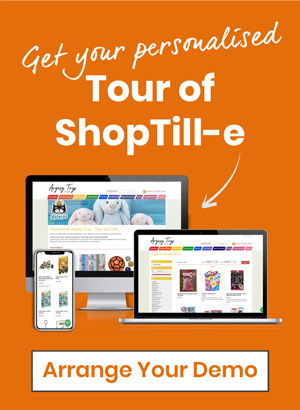Juggling the demands of both your physical shop and your online presence can be a challenge. After all, it's hard to be in two places at once!
But what if there was a simpler solution? What if you could use one system to do all of this? Wouldn't that be better? Well, of course, it would.
In this blog post, we're going to talk about how you can breakdown the barriers between your physical shop and ecommerce shop so you can get back to focusing on what matters - growing your business.
Key challenges facing retailers today
Businesses selling online and offline face the following problems:
1. Inconsistent product information across channels
We're living in an omnichannel world – where people may research your products online and then come in to buy them in person, or vice versa. It's important to be aware of those customer expectations and make sure that product information and sales are consistent across all channels – especially if you have an ecommerce website that's separate from your point-of-sale system where customers shop in-store.
2. Not tracking stock in real-time
Another problem that retailers often run into is tracking stock easily. This is especially difficult when your point of sale system and your ecommerce platform are two separate things.
What happens if you sell more in your shop, how do you log that in your ecommerce shop and vice versa? What happens if you forget to log a sale? This juggling of stock can be an administrative nightmare with a continual risk of overselling.
3. Time and duplication
You're essentially duplicating work by updating information and products in both places.
Not only does this take time, but it also means training staff on two different systems, which can lead to errors.
What are the solutions?
1. Get the two systems to talk
You could get the two systems to talk, but there are issues with this too. To start with you will probably be charged for any connectors and integrations between the separate parties.
And sometimes it's not a full integration, only sales and stock, so you still need to manage the two systems.
There can also be a time lag between any updates, so your data and stock levels may not be completely uptodate or in real-time which could lead to an overselling of products.
It can also have points of failure in that if there’s an update on one system it may not then be compatible with the other system, which can stop it from working, putting you in frustrating support loops where each party points the finger at one another.
2. Implement an all-in-one retail system
With an all-in-one retail system all the data is run and managed in one place which saves a huge amount of time and effort.
Most of the time spent entering products, updating inventory and managing sales across the various platforms can be saved by operating from a single central hub which connects all the dots.
You can efficiently sell your products where your customers are whether that's in-store, online, eBay, Amazon, Instagram, Facebook, Google Shopping etc, and make it easy to buy, no matter what platform your customers are on.
Benefits of using an all-in-one retail system
There are many ways to bridge the gap between your online and physical shops. And all those ways are great! But if you could run your entire business with just one system wouldn't that give you more time to focus on growing your business instead of running around from program to program trying to stay on top of things?
The benefits are many….
1. No duplication
Only having to add your products once can be a real game changer. Think of the time you’ll save when you only need to enter information in one place and your ePOS system and ecommerce website updates at the same time eg update a price and it will automatically reflect in your ePOS (point of sale system) as well as your ecommerce store and vice versa.
2. Synchronised real-time inventory management
Whenever someone buys an item, either in-store or online, your sales and inventory data are automatically synchronised in real-time. You don't have to worry about your ecommerce store talking to your in-store point of sale because it's an all-in-one system that does it seamlessly.
This means that you never need to worry about overselling your products or having inaccurate data.
3. Promotions, discounts, special deals that work across each sales channel
Savvy customers don’t want to see different prices in-store and online especially when it comes to promotions. If they’ve done their research online they expect to see the same promotions and pricing when they come in-store.
The right all-in-one retail system should make setting-up and running cross channel promotions easy, whether a customer buys in-store or online, the ePOS system and ecommerce website will track their purchases and allow them to use their promotional codes in-store or online, giving them an amazing brand experience.
4. Implement click and collect
An all-in-one system will make it easy to implement Click and Collect. This is when you allow customers to browse for products on your website, place orders for those products there, and they then pick them up at your brick-and-mortar shop.
This service gives your customers the convenience and ease of shopping online by allowing them to choose how they wish to receive their purchase.
It’s a great cost saver too, because if you’re not offering free shipping it means they can save on any delivery fees that they would normally be charged which encourages the sale, as well as helping you to reduce any delivery costs that you would normally incur when sending by courier.
5. Improved business visibility and better product performance insights
If using different systems it can be difficult to oversee the whole of your retail business, as different information will be held on each platform, but with an all-in-one retail system everything is connected and integrated within one system allowing retailers to better understand trends, adapt quickly and make smart purchasing decisions.
6. Reduced overall costs
Running separate systems not only takes away valuable time but also comes with the associated costs of running more than one system.
Depending on the all-in-one retail system you choose, this can bring a potential for reduced overall costs as you will be paying for just one system.
Multichannel selling
The key to maximise sales and profits is to offer your customers with every possible way to purchase your products through multichannel retailing and that may mean you need to replace your outdated legacy systems with an intuitive and customer-focused retail solution, that not only provides a seamless customer experience, but crucially allows you to manage this efficiently and cost-effectively.
ShopTill-e has been specifically created to meet the demands of modern multichannel retailing.
The cloud point of sale system and ecommerce platform provides retailers with all the features needed to run, sell, manage, and grow.
Don't believe us? Book a free demo today.




